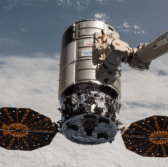Despite his background partnering with the Department of Defense on communications technologies projects, Rick Lober had never worked in satellites until he arrived at Hughes Network Systems in 2008. Now, he’s at the forefront of the company’s Defense and Government Systems division, helping to bring its SATCOM offerings to serve the mission of the DOD, federal government agencies and the U.S. Intelligence Community. As vice president and general manager of the Defense and Government Systems division, Lober leads a team of program managers and business development specialists as well as engineering and operations personnel to develop customized products to the MILSATCOM command, control, communications, computers, intelligence, surveillance and reconnaissance market.
Prior to his time at Hughes, Lober was senior vice president and GM of the communications business unit at Cubic Corporation. Before that, he spent many years at former electronics manufacturer Watkins-Johnson Company, where he established a commercial telecom unit that applied and adapted existing defense systems to the private sector.
In this Executive Spotlight interview, Lober gives an exclusive look at forthcoming projects at Hughes, such as a new LEO offering, a 5G satellite project and the company’s ongoing interest in software-defined networking.

Digital twins are another ascendent technology making a huge impact on the satellite industry and beyond. If you want to know more from some of the U.S. government’s foremost experts on the subject, attend ExecutiveBiz’s virtual Digital Twins Forum on Nov. 1. Register here now.
Where are you seeing the most exciting opportunities to deliver better capabilities to our warfighters today, and how are you harnessing these opportunities?
There is a lot of emphasis on low Earth orbit, or LEO satellites versus the more conventional geostationary orbit, or GEO satellites. LEO gives you polar coverage, lower latency and a good amount of resilience. Hughes has developed a LEO offering based on a OneWeb constellation that will be fully operational by Q4. We’re finishing a lot of work on the development of the OneWeb ground system and we’re also a value-added reseller. Additionally, we’re developing an electronically steered antenna array, or ESA, for use with this LEO constellation. There is a lot of interest in LEO from the Department of Defense because of its resilience. However, when you need high capacity in one area, we continue to offer our high throughput GEO satellites or a combination of both.
Our view is that you’ll need multiple orbits to meet the DOD mission — LEO, GEO and medium Earth orbit, or MEO. We’ve already brought multipath solutions to market, including our Hughes Fusion consumer offering and soon an In Flight offering which can connect airplane passengers to both a GEO and LEO network — delivering a snappy, low latency experience with pole-to-pole service including over high-density airline hubs.
Another area of interest is 5G communications — terrestrial and non-terrestrial. We were fortunate to be named the prime contractor creating a private 5G network at Naval Air Station Whidbey Island. That project has gone very well and we hope to see it expand. We’re also looking at bringing 5G up to the satellite, so we’ll have 5G direct from the satellite to the phone, which will change the way that the DOD communicates. The biggest innovations in satellite communications today are LEO and 5G, which you’re hearing about within the DOD and commercial community.
What emerging technologies do you anticipate will have the greatest impact on our standing in the great power competition in the next few years? Where are you seeing opportunities for accelerated, meaningful tech growth for the U.S.?
We’ll see continued growth in LEO. OneWeb’s constellation is up, the Starlink constellation is up, and it looks like Telsat and Project Kuiper will get there in a couple of years. Then, you couple that with the work the Space Development Agency is doing in LEO. One of the things I think is important for LEO is to have optical communication links between the satellites. Optical communication will be a real driver of growth. The ability to connect LEO satellites and even LEO to GEO together optically will be important moving forward because it allows for global coverage and very rapid and secure transfer of comms or space sensor data to a commander on the ground or to a weapons system.
Another key area is what we call software-defined networking, which takes advantage of the fact that most communication today is packet-based. The message is divided into small packets, which can be sent over GEO, MEO, LEO and/or terrestrial paths, using software-defined networking to make these transport choices.
Finally, I would add artificial intelligence. Uses of AI now span various areas — customer service, network management, etc. Our defense group has applied AI to what we call Primary Alternative Contingency Emergency Communications, or PACE, a DOD acronym for looking at options if your communications go down. Applying rules-based software or AI to your emergency response plans can provide significant advantages, including greater resiliency across communications channels.
How is your organization adapting and responding to the proliferation of sensors and the rapid expansion of the Internet of Things?
We are developing a constellation in S-band called EchoStar Lyra that will enable narrowband communications like texting, voice and IoT. This will be a 28-satellite constellation going up in the next couple years that will allow for store and forward messaging. In the future, we may build on it to create a full non-terrestrial 5G constellation.
As the number of IoT devices grows across DoD networks, software-defined networking will be key to keeping these devices online and working in sync.
Finally, because of the speeds and extreme low latency it offers, 5G allows for what we call smart processing at the edge. This means making decisions right on the battlefield or at the edge of the network without sending all data back to a cloud. Together, our investments in software-defined networking and the new S-band constellation will help the DOD realize the full potential of IoT devices.
What are our biggest threats in space, and how are we addressing those threats to maintain our space superiority, especially during this era of increasing competition?
Up until recently, space has always been hands-off. I believe the U.S. has consistently had an edge in space, although that’s potentially changing as other countries advance. It seems like the next major escalation might be space-based. So, we worry a lot about network denial, especially on the commercial side of things, not just the DOD. For example, that could include an attack potentially taking down critical infrastructure networks including energy, financial and electrical systems. GPS denial is also a significant concern because so much depends on it. People often think of GPS for navigation, but our banking and communication systems also rely on it.
To counter these threats, I believe the proliferation of LEO satellites will help. You can achieve positioning, navigation and timing, or PNT, using LEO satellites, which might even surpass what we see with GPS today. Additionally, the use of software-defined networking can reroute signals along different paths if one path is disrupted or obfuscate signals by using multiple paths. Finally, the resilience provided by multiple satellite constellations, whether GEO or LEO, will be crucial in countering these threats.

Digital twin replicas of physical objects, systems and processes are enabling the government to gain more advanced understandings every day. Find out how the industrial base can aid and partner in this revolution at ExecutiveBiz’s Digital Twins Forum on Nov. 1. Register here today!





